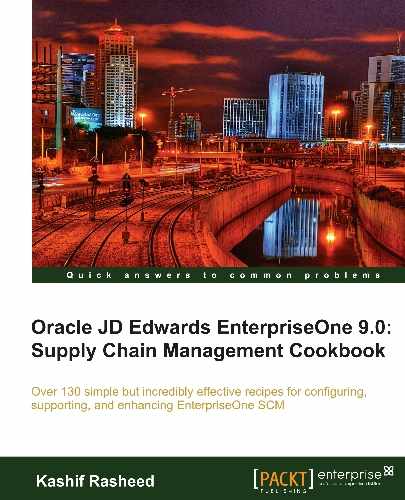This recipe provides an outline for locating item and quantity information so that you can:
- Locate item information
- Locate quantity information
- Work with transaction records
For locating item information and quantity you should set up the processing options of Item Availability Application (P41202).
- From Inventory Master/Transactions (G4111) | Item Master | Work with Item Master Browse, locate Items for Item Master and click Select and then Review Item Master.
- On the Work With Item Master Browse form, select Item Word Search from the Form menu | Item Word Search, and then enter the item search text.
- Click Find to locate the items.

- Select Item Search from the form menu on any of the transaction entry forms, such as Inventory Adjustments, Item Search Returning Quantity (P40ITM2), and locate the items for transaction.

- Select a record from the grid, and then select Cross Reference from the Row menu on the Work with Item Search form. You will see the Work with Item Cross Reference for defining the Search Criteria.
- From Inventory Inquiries (G41112) | Item Search | Work With Item Search, enter the search text for finding the correct model and brand of printer.
- Refer to the following screenshot to set up the processing options for Item Availability (P41202). Click on the arrow for Summary Availability and then click on Values.

- On the Version tab, leave the processing options blank, and the system will use ZJDE0001 version as a default.
- On the Display tab, select 1 to specify that the system should display quantity information in the primary unit of measure.
There are a variety of reasons why you might want to locate item information, such as entering changes to inventory, revising the information that is associated with inventory items, or reviewing available quantities. You can use three methods to locate item information. The method that you select depends on the type of search criteria that you use and where the method is available:
- The first method is Locating Items with a Word Search, which is available when you are using Item Master or any transaction entry form (Issues, Transfers, Adjustments, and Reclassifications).
- The second method is Locating and Returning Item Information which is available when you are using any transaction entry form (Issues, Transfers, Adjustments, and Reclassifications).
- The third method is locating item information with item search, which is available from a search button from the Item Number field and from the Inventory Inquiries menu (G41112).
The system does not display decimal quantities if the Display Decimals field in the Quantity On Hand-Primary Quantity (PQOH) data item has no display decimals specified. The Summary Only checkbox indicates that the system will display information that is summarized by item, company, currency code, and cost rule. If you do not select this checkbox, the system displays individual receipt records. The Omit Zero Quantities checkbox indicates that the system does not display information with zero on-hand quantities. If you do not select this checkbox, the system displays information with zero on-hand quantities.
You can locate the item quantity on many different columns of the item availability application.

First, you received the quantity at the warehouse, and then you received the quantity in JDE. Through Receipt Entry, Inventory Adjustment, Transfer Receipt, or Inventory Transfer, the system will update the on-hand quantity in the F41021 table. The on-hand inquiry will read the data from F41021. The system displays the quantity on-hand in the primary unit of measure. Committed shows the total quantity that is committed at a specific location. The total quantity is the sum of all quantities that have been sold, soft committed, or hard committed to sales orders and work orders. You can review the total committed quantity on the Customer Service Inquiry form by specifying a status of less than 999. Available shows the quantity that is available. For example, the available quantity might consist of the on-hand quantity minus commitments, reservations, and backorders. Availability is user defined. You can define how availability is calculated in the Branch/Plant Constants program (P41001).

Grade Range is a code from UDC 40/LG that indicates the minimum grade that is acceptable for an item. The system displays a warning message if you try to purchase or issue items with grades that do not meet the minimum grade acceptable. The system does not allow you to sell items with grades that do not meet the minimum acceptable level.
Potency Range determines whether the system displays the Percent of Life Remaining field. If you do not choose this option, the system does not display the Percent of Life Remaining field.
